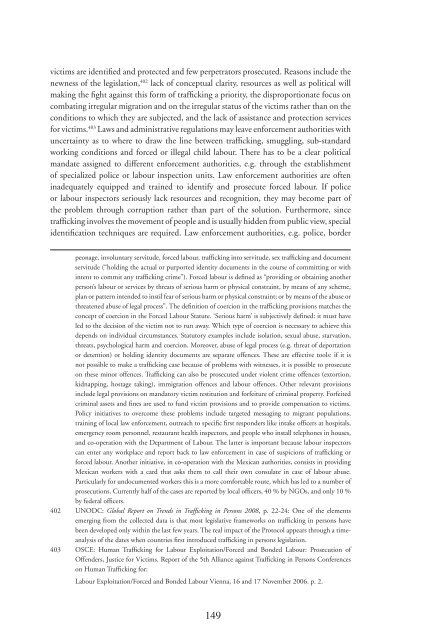Trafficking in human beings: human rights and ... - unesdoc - Unesco
Trafficking in human beings: human rights and ... - unesdoc - Unesco
Trafficking in human beings: human rights and ... - unesdoc - Unesco
Create successful ePaper yourself
Turn your PDF publications into a flip-book with our unique Google optimized e-Paper software.
victims are identifi ed <strong>and</strong> protected <strong>and</strong> few perpetrators prosecuted. Reasons <strong>in</strong>clude the<br />
newness of the legislation, 402 lack of conceptual clarity, resources as well as political will<br />
mak<strong>in</strong>g the fi ght aga<strong>in</strong>st this form of traffi ck<strong>in</strong>g a priority, the disproportionate focus on<br />
combat<strong>in</strong>g irregular migration <strong>and</strong> on the irregular status of the victims rather than on the<br />
conditions to which they are subjected, <strong>and</strong> the lack of assistance <strong>and</strong> protection services<br />
for victims. 403 Laws <strong>and</strong> adm<strong>in</strong>istrative regulations may leave enforcement authorities with<br />
uncerta<strong>in</strong>ty as to where to draw the l<strong>in</strong>e between traffi ck<strong>in</strong>g, smuggl<strong>in</strong>g, sub-st<strong>and</strong>ard<br />
work<strong>in</strong>g conditions <strong>and</strong> forced or illegal child labour. There has to be a clear political<br />
m<strong>and</strong>ate assigned to different enforcement authorities, e.g. through the establishment<br />
of specialized police or labour <strong>in</strong>spection units. Law enforcement authorities are often<br />
<strong>in</strong>adequately equipped <strong>and</strong> tra<strong>in</strong>ed to identify <strong>and</strong> prosecute forced labour. If police<br />
or labour <strong>in</strong>spectors seriously lack resources <strong>and</strong> recognition, they may become part of<br />
the problem through corruption rather than part of the solution. Furthermore, s<strong>in</strong>ce<br />
traffi ck<strong>in</strong>g <strong>in</strong>volves the movement of people <strong>and</strong> is usually hidden from public view, special<br />
identifi cation techniques are required. Law enforcement authorities, e.g. police, border<br />
peonage, <strong>in</strong>voluntary servitude, forced labour, traffi ck<strong>in</strong>g <strong>in</strong>to servitude, sex traffi ck<strong>in</strong>g <strong>and</strong> document<br />
servitude (“hold<strong>in</strong>g the actual or purported identity documents <strong>in</strong> the course of committ<strong>in</strong>g or with<br />
<strong>in</strong>tent to commit any traffi ck<strong>in</strong>g crime”). Forced labour is defi ned as “provid<strong>in</strong>g or obta<strong>in</strong><strong>in</strong>g another<br />
person’s labour or services by threats of serious harm or physical constra<strong>in</strong>t, by means of any scheme,<br />
plan or pattern <strong>in</strong>tended to <strong>in</strong>stil fear of serious harm or physical constra<strong>in</strong>t; or by means of the abuse or<br />
threatened abuse of legal process”. The defi nition of coercion <strong>in</strong> the traffi ck<strong>in</strong>g provisions matches the<br />
concept of coercion <strong>in</strong> the Forced Labour Statute. ‘Serious harm’ is subjectively defi ned: it must have<br />
led to the decision of the victim not to run away. Which type of coercion is necessary to achieve this<br />
depends on <strong>in</strong>dividual circumstances. Statutory examples <strong>in</strong>clude isolation, sexual abuse, starvation,<br />
threats, psychological harm <strong>and</strong> coercion. Moreover, abuse of legal process (e.g. threat of deportation<br />
or detention) or hold<strong>in</strong>g identity documents are separate offences. These are effective tools: if it is<br />
not possible to make a traffi ck<strong>in</strong>g case because of problems with witnesses, it is possible to prosecute<br />
on these m<strong>in</strong>or offences. Traffi ck<strong>in</strong>g can also be prosecuted under violent crime offences (extortion,<br />
kidnapp<strong>in</strong>g, hostage tak<strong>in</strong>g), immigration offences <strong>and</strong> labour offences. Other relevant provisions<br />
<strong>in</strong>clude legal provisions on m<strong>and</strong>atory victim restitution <strong>and</strong> forfeiture of crim<strong>in</strong>al property. Forfeited<br />
crim<strong>in</strong>al assets <strong>and</strong> fi nes are used to fund victim provisions <strong>and</strong> to provide compensation to victims.<br />
Policy <strong>in</strong>itiatives to overcome these problems <strong>in</strong>clude targeted messag<strong>in</strong>g to migrant populations,<br />
tra<strong>in</strong><strong>in</strong>g of local law enforcement, outreach to specifi c fi rst responders like <strong>in</strong>take offi cers at hospitals,<br />
emergency room personnel, restaurant health <strong>in</strong>spectors, <strong>and</strong> people who <strong>in</strong>stall telephones <strong>in</strong> houses,<br />
<strong>and</strong> co-operation with the Department of Labour. The latter is important because labour <strong>in</strong>spectors<br />
can enter any workplace <strong>and</strong> report back to law enforcement <strong>in</strong> case of suspicions of traffi ck<strong>in</strong>g or<br />
forced labour. Another <strong>in</strong>itiative, <strong>in</strong> co-operation with the Mexican authorities, consists <strong>in</strong> provid<strong>in</strong>g<br />
Mexican workers with a card that asks them to call their own consulate <strong>in</strong> case of labour abuse.<br />
Particularly for undocumented workers this is a more comfortable route, which has led to a number of<br />
prosecutions. Currently half of the cases are reported by local offi cers, 40 % by NGOs, <strong>and</strong> only 10 %<br />
by federal offi cers.<br />
402 UNODC: Global Report on Trends <strong>in</strong> Traffi ck<strong>in</strong>g <strong>in</strong> Persons 2008, p. 22-24: One of the elements<br />
emerg<strong>in</strong>g from the collected data is that most legislative frameworks on traffi ck<strong>in</strong>g <strong>in</strong> persons have<br />
been developed only with<strong>in</strong> the last few years. The real impact of the Protocol appears through a timeanalysis<br />
of the dates when countries fi rst <strong>in</strong>troduced traffi ck<strong>in</strong>g <strong>in</strong> persons legislation.<br />
403 OSCE: Human Traffi ck<strong>in</strong>g for Labour Exploitation/Forced <strong>and</strong> Bonded Labour: Prosecution of<br />
Offenders, Justice for Victims. Report of the 5th Alliance aga<strong>in</strong>st Traffi ck<strong>in</strong>g <strong>in</strong> Persons Conferences<br />
on Human Traffi ck<strong>in</strong>g for:<br />
Labour Exploitation/Forced <strong>and</strong> Bonded Labour Vienna, 16 <strong>and</strong> 17 November 2006. p. 2.<br />
149

















